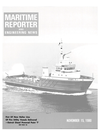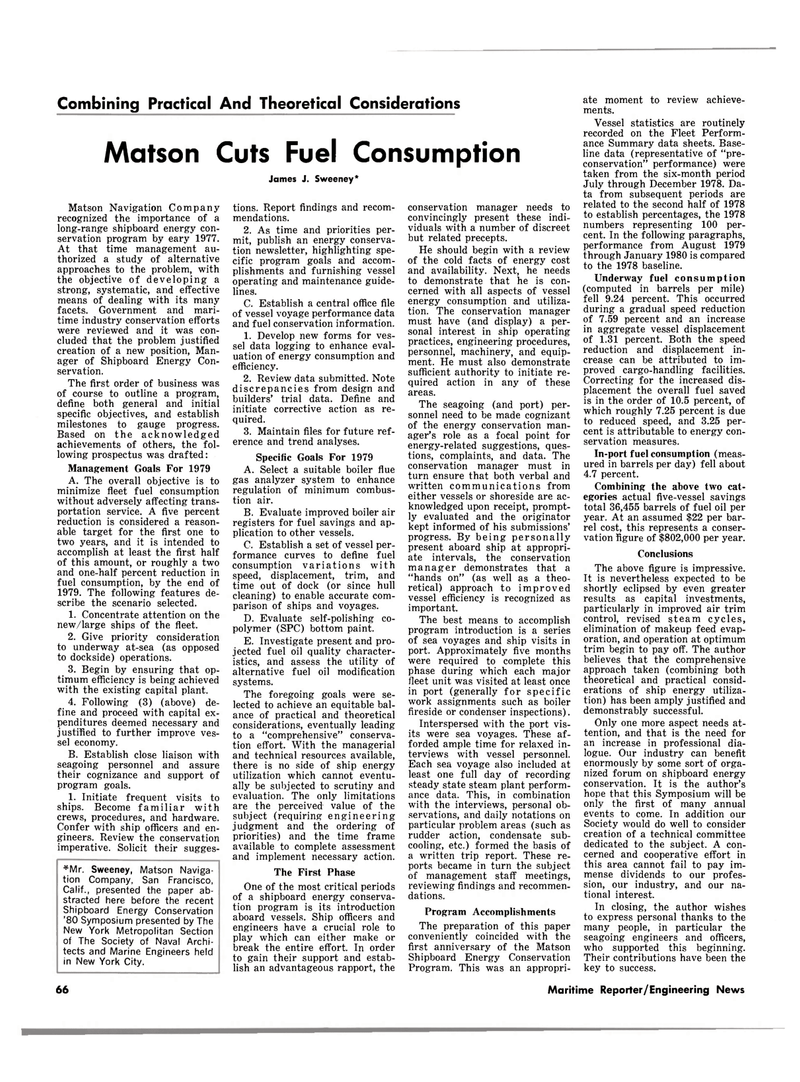
Page 64: of Maritime Reporter Magazine (November 15, 1980)
Read this page in Pdf, Flash or Html5 edition of November 15, 1980 Maritime Reporter Magazine
Combining Practical And Theoretical Considerations
Matson Cuts Fuel Consumption
James J. Sweeney*
Matson Navigation Company recognized the importance of a long-range shipboard energy con- servation program by eary 1977.
At that time management au- thorized a study of alternative approaches to the problem, with the objective of developing a strong, systematic, and effective means of dealing with its many facets. Government and mari- time industry conservation efforts were reviewed and it was con- cluded that the problem justified creation of a new position, Man- ager of Shipboard Energy Con- servation.
The first order of business was of course to outline a program, define both general and initial specific objectives, and establish milestones to gauge progress.
Based on the acknowledged achievements of others, the fol- lowing prospectus was drafted:
Management Goals For 1979
A. The overall objective is to minimize fleet fuel consumption without adversely affecting trans- portation service. A five percent reduction is considered a reason- able target for the first one to two years, and it is intended to accomplish at least the first half of this amount, or roughly a two and one-half percent reduction in fuel consumption, by the end of 1979. The following features de- scribe the scenario selected. 1. Concentrate attention on the new/large ships of the fleet. 2. Give priority consideration to underway at-sea (as opposed to dockside) operations. 3. Begin by ensuring that op- timum efficiency is being achieved with the existing capital plant. 4. Following (3) (above) de- fine and proceed with capital ex- penditures deemed necessary and justified to further improve ves- sel economy.
B. Establish close liaison with seagoing personnel and assure their cognizance and support of program goals. 1. Initiate frequent visits to ships. Become familiar with crews, procedures, and hardware.
Confer with ship officers and en- gineers. Review the conservation imperative. Solicit their sugges- tions. Report findings and recom- mendations. 2. As time and priorities per- mit, publish an energy conserva- tion newsletter, highlighting spe- cific program goals and accom- plishments and furnishing vessel operating and maintenance guide- lines.
C. Establish a central office file of vessel voyage performance data and fuel conservation information. 1. Develop new forms for ves- sel data logging to enhance eval- uation of energy consumption and efficiency. 2. Review data submitted. Note discrepancies from design and builders' trial data. Define and initiate corrective action as re- quired. 3. Maintain files for future ref- erence and trend analyses.
Specific Goals For 1979
A. Select a suitable boiler flue gas analyzer system to enhance regulation of minimum combus- tion air.
B. Evaluate improved boiler air registers for fuel savings and ap- plication to other vessels.
C. Establish a set of vessel per- formance curves to define fuel consumption variations with speed, displacement, trim, and time out of dock (or since hull cleaning) to enable accurate com- parison of ships and voyages.
D. Evaluate self-polishing co- polymer (SPC) bottom paint.
E. Investigate present and pro- jected fuel oil quality character- istics, and assess the utility of alternative fuel oil modification systems.
The foregoing goals were se- lected to achieve an equitable bal- ance of practical and theoretical considerations, eventually leading to a "comprehensive" conserva- tion effort. With the managerial and technical resources available, there is no side of ship energy utilization which cannot eventu- ally be subjected to scrutiny and evaluation. The only limitations are the perceived value of the subject (requiring engineering judgment and the ordering of priorities) and the time frame available to complete assessment and implement necessary action.
The First Phase
One of the most critical periods of a shipboard energy conserva- tion program is its introduction aboard vessels. Ship officers and engineers have a crucial role to play which can either make or break the entire effort. In order to gain their support and estab- lish an advantageous rapport, the conservation manager needs to convincingly present these indi- viduals with a number of discreet but related precepts.
He should begin with a review of the cold facts of energy cost and availability. Next, he needs to demonstrate that he is con- cerned with all aspects of vessel energy consumption and utiliza- tion. The conservation manager must have (and display) a per- sonal interest in ship operating practices, engineering procedures, personnel, machinery, and equip- ment. He must also demonstrate sufficient authority to initiate re- quired action in any of these areas.
The seagoing (and port) per- sonnel need to be made cognizant of the energy conservation man- ager's role as a focal point for energy-related suggestions, ques- tions, complaints, and data. The conservation manager must in turn ensure that both verbal and written communications from either vessels or shoreside are ac- knowledged upon receipt, prompt- ly evaluated and the originator kept informed of his submissions' progress. By being personally present aboard ship at appropri- ate intervals, the conservation manager demonstrates that a "hands on" (as well as a theo- retical) approach to improved vessel efficiency is recognized as important.
The best means to accomplish program introduction is a series of sea voyages and ship visits in port. Approximately five months were required to complete this phase during which each major fleet unit was visited at least once in port (generally for specific work assignments such as boiler fireside or condenser inspections).
Interspersed with the port vis- its were sea voyages. These af- forded ample time for relaxed in- terviews with vessel personnel.
Each sea voyage also included at least one full day of recording steady state steam plant perform- ance data. This, in combination with the interviews, personal ob- servations, and daily notations on particular problem areas (such as rudder action, condensate sub- cooling, etc.) formed the basis of a written trip report. These re- ports became in turn the subject of management staff meetings, reviewing findings and recommen- dations.
Program Accomplishments
The preparation of this paper conveniently coincided with the first anniversary of the Matson
Shipboard Energy Conservation
Program. This was an appropri- ate moment to review achieve- ments.
Vessel statistics are routinely recorded on the Fleet Perform- ance Summary data sheets. Base- line data (representative of "pre- conservation" performance) were taken from the six-month period
July through December 1978. Da- ta from subsequent periods are related to the second half of 1978 to establish percentages, the 1978 numbers representing 100 per- cent. In the following paragraphs, performance from August 1979 through January 1980 is compared to the 1978 baseline.
Underway fuel consumption (computed in barrels per mile) fell 9.24 percent. This occurred during a gradual speed reduction of 7.59 percent and an increase in aggregate vessel displacement of 1.31 percent. Both the speed reduction and displacement in- crease can be attributed to im- proved cargo-handling facilities.
Correcting for the increased dis- placement the overall fuel saved is in the order of 10.5 percent, of which roughly 7.25 percent is due to reduced speed, and 3.25 per- cent is attributable to energy con- servation measures.
In-port fuel consumption (meas- ured in barrels per day) fell about 4.7 percent.
Combining the above two cat- egories actual five-vessel savings total 36,455 barrels of fuel oil per year. At an assumed $22 per bar- rel cost, this represents a conser- vation figure of $802,000 per year.
Conclusions
The above figure is impressive.
It is nevertheless expected to be shortly eclipsed by even greater results as capital investments, particularly in improved air trim control, revised steam cycles, elimination of makeup feed evap- oration, and operation at optimum trim begin to pay off. The author believes that the comprehensive approach taken (combining both theoretical and practical consid- erations of ship energy utiliza- tion) has been amply justified and demonstrably successful.
Only one more aspect needs at- tention, and that is the need for an increase in professional dia- logue. Our industry can benefit enormously by some sort of orga- nized forum on shipboard energy conservation. It is the author's hope that this Symposium will be only the first of many annual events to come. In addition our
Society would do well to consider creation of a technical committee dedicated to the subject. A con- cerned and cooperative effort in this area cannot fail to pay im- mense dividends to our profes- sion, our industry, and our na- tional interest.
In closing, the author wishes to express personal thanks to the many people, in particular the seagoing engineers and officers, who supported this beginning.
Their contributions have been the key to success. *Mr. Sweeney, Matson Naviga- tion Company, San Francisco,
Calif., presented the paper ab- stracted here before the recent
Shipboard Energy Conservation '80 Symposium presented by The
New York Metropolitan Section of The Society of Naval Archi- tects and Marine Engineers held in New York City. 66 Maritime Reporter/Engineering News

 63
63

 65
65
